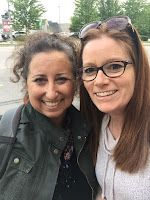In the summer of 2016 my Twitter feed started to flood with #HyperDocs. Intrigued, I started to explore post and immediately bought the book by Lisa Highfill, Sarah Landis, and Kelly Hilton. I was about to start a new position as an instructional coach and as much I wanted to try them out in the classroom, I could not wait to share HyperDoc with other teachers.
 |
| If you ever meet Lisa ask her about her first trip to Toronto...it's a good story wherein I almost had her deported! |
HyperDocs are Google Docs, with interactive elements, designed to replace the worksheet method of delivering instruction. By sharing a link to a HyperDoc, teachers can get students thinking, exploring, collaborating, and creating all on their own, shifting teachers from the lecturer to listener. With HyperDocs, teachers can personalize the learning experience and better connect with students.
People often call Multimedia Text Sets (MTS) HyperDocs, but this is a misnomer - HyperDocs are so much more than that. (Note: MTSs are also called Choice boards - a term coined by Derek Tangredi - which I love.) A lot of people also see HyperDocs and call them clickable Docs, or a webquest...but again, it is more than that.
The HyperDoc cycle is robust. It includes Engaging, Exploring, Explaining, Applying, Sharing, Reflecting, and Extending. The idea is that in order to have students fully engage in the learning, all seven parts of the cycle should be followed. Choice boards can be used to support some (or all) parts, but it is the pedagogy behind the curation of the board and the involvement in each part that really matters.
In the Engagement phase we draw in the learner - peak their curiosity, and hook them into the learning. In Explore students engage in self-directed learning. This phase is often facilitated through an MTS/Choice Board so the needs of the individual learner can be met. Some might want to watch a video, others might want an online manipulative, and still others might like to read an article. In Explain, the teacher, after seeing the learning in the Explore phase, goes back and fills gaps they noticed in the students learning. Next, students Apply. To me, this is one of the most important phases as it takes students from consumer to creator. I actually call this the Create phase in stead of Apply. I also always give choice in this phase. What one students might present in a video another could do in a podcast, or poster. I feel learners should be able to show me how they have made understanding. Sharing is the next phase and I always emphasize the importance of letting learners share to an authentic audience. I really feel if the only audience is the teacher than the learners produces for that teacher, and not for the learners him/herself --> which is when the magic happens. Reflection allows learners to think about the learning that has taken and really spend some time becoming aware and understanding one's own thought processes. This helps with growth. Finally, Extending takes the learning beyond what might be covered traditionally. It allows the learners who is really keen on the subject to explore in more depth or in a different way.
Above all, there are only two rules with HyperDocs - share freely and give credit!
Here are some Choice Boards I have created.
- Authentic Student Directed Learning
- Tech Tools for the English Classroom
- Become a GSuite Wizard
- EdTech Team Peel Summit
I created this resource for EdTech Tools to use with each phase of the cycle. Note: I update this regularly so feel free to share and add to your drive but if you make a copy it will not be updated.
Here is my What's the Hype with HyperDocs slide deck. I particularly like the slide about how a lesson looks transferred from traditional to HyperDoc (Thanks Lisa for sharing). Also, I like the slide with the choice boards for 4Cs.
Are you on Twitter? Some of my fav HyperDoc people include not only the HyperDoc ladies linked above, but also:
- TsGiveTs <-- this is the joint account for all 3 ladies
- Karly Moura
- Sean Fahey
- Nicole Beardsley
- Holly Clark
- Stephanie Signer




I really love this post. I have looked a lot of places (including the Hyperdocs Playbook and teachersgiveteachers and hyperdocs.co) all over the web for a good way to explain Hyperdocs to my school division. You have an excellent blog and I really like your slide deck on hyperdocs as well!
ReplyDeleteAfter seeing you all post about Hyperdocs on Twitter, I knew I had to learn more. I'm happy to say that this past summer I completed the online Hyperdocs Bootcamp course! Yay! B/c I was a total newbie, parts of it were really challenging to me, but I learned so much, and I had so much fun! :-) Thank you for your help and support through this wonderful blog and your Twitter acct - your are an inspiration! Your enthusiasm and positivity are contagious. Keep being awesome and thanks again! :-)
ReplyDelete